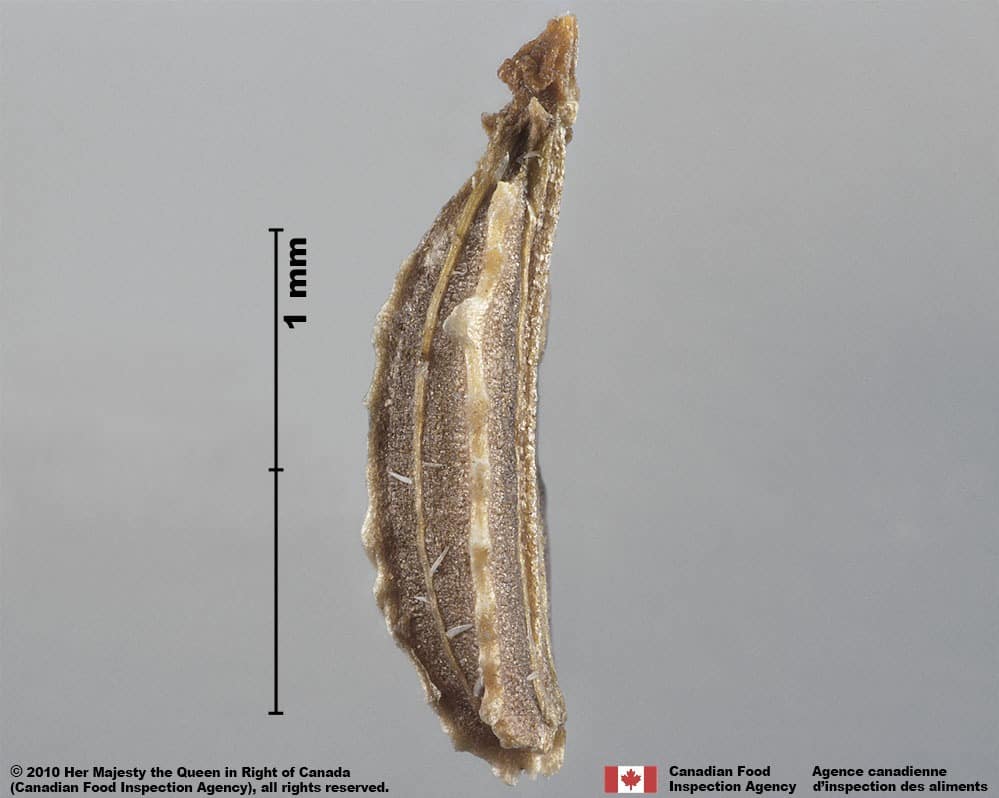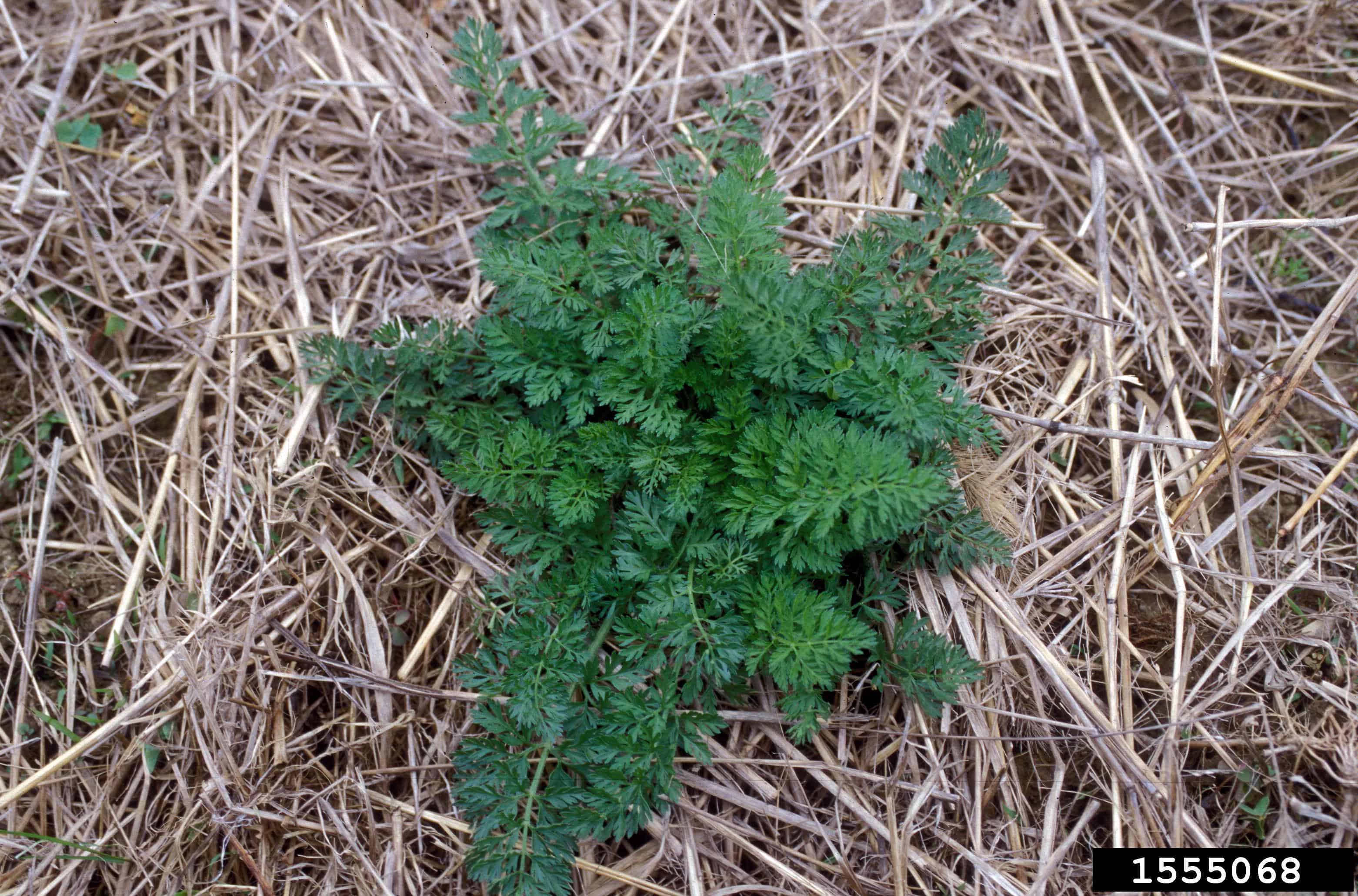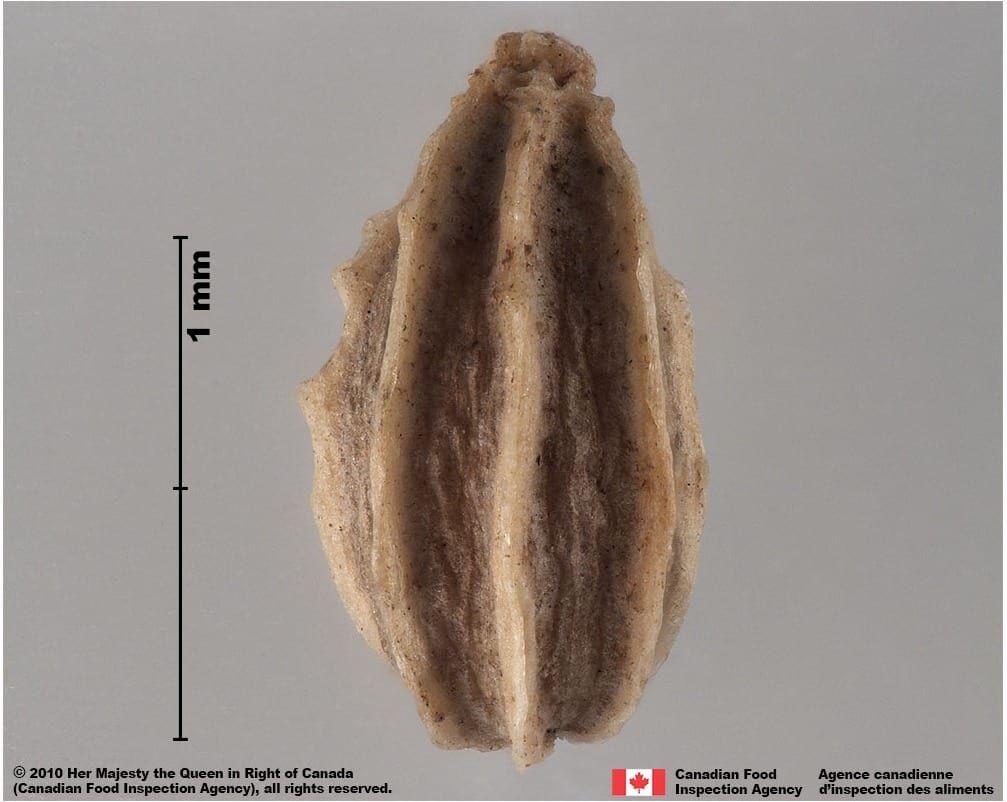Daucus carota subsp. carota
Overview
Aperçu
Regulation :
Remarques Réglementation:
- CFIA Weed Seeds Order - Class 3: Secondary Noxious Weed Seeds
- USA Federal Noxious Weed Seed List
Regulation Notes:
Distribution :
Répartition :
The species is native to Europe, northern Africa and southwestern Asia (CABI 2022; USDA-ARS 2022). It has been widely introduced elsewhere in temperate regions including China, Japan, Australasia and North America (CABI 2022; USDA-ARS 2022). It occurs across Canada except for Yukon, Northwest Territories and Nunavut (Brouillet et al. 2010+).
Habitat and Crop Association :
Habitat et Cultures Associées :
Waste places, roadsides and disturbed areas, old fields, meadows and underused or depleted pastures (Dale 1974; Darbyshire 2003). Not typically considered a weed of cultivated fields on prime agricultural land but increasingly found in no-till production systems (Dale 1974; Cowbrough 2004). Reported in Zea mays subsp. mays (corn), Glycine max (soybeans) and Triticum aestivum subsp. aestivum (winter wheat) in Ontario (Cowbrough 2004).
Economic Use, cultivation area, and Weed Association :
Utilisation économique, zone de culture et association de mauvaises herbes :
Duration of Life Cycle :
Durée du cycle vital:
Biennial
Dispersal Unit Type :
Type d’unité de dispersion :
Schizocarp, divided into 2 mericarps
General Information
RENSEIGNEMENTS GÉNÉRAUX
Daucus carota subsp. carota spread to North America through garden plantings and escaped to become a weed of roadsides and waste places (Darbyshire 2003; DiTomaso and Healy 2007). It may also have been introduced as a seed contaminant (CABI 2022). D. carota subsp. carota hybridizes readily with D. carota subsp. sativa (cultivated carrot) (DiTomaso and Healy 2007) and was first reported in Ontario and Quebec in 1883 (Royer and Dickinson 1999).
Mericarps are spread by wind, or by attachment to animals and clothing; they may also be spread in contaminated seed or grain (Dale 1974; CABI 2022). Individual plants produce 1000-40,000 mericarps that remain viable in the soil for several years (Dale 1974).
.
Daucus carota ssp. carota infestation (Ohio State Weed Lab , The Ohio State University, Bugwood.org)
Identification
Identification
-
Mericarp
Size
- Mericarp 1.7 – 3.5 mm; width: 1.1 – 2.2 mm
*Note: minimum and maximum of 20 mericarps in a normal range of this species using image measurement (ISMA 2020)
Shape
- Oval to teardrop-shaped, plano-convex, and compressed in edge view
Surface Texture
- Mericarp surface smooth or roughened
- Five longitudinal ribs on the convex side and edges, two ribs on the flat side
Colour
- Mericarp dull, grey-brown or brown with straw yellow ribs
Other Features
Mericarp end with style remnant
- Style remnant is short triangular shaped and dull straw yellow coloured
- Linear connective tissue between the mericarps may remain attached to the style remnant
- The connective tissue may extend the length of the flat side, giving the appearance of a third rib
Other features
- Mericarp ribs are generally winged with long bristles
- Typical long wings and bristles could be broken or absent if processed, immature or damaged
- Small hairs present along each rib close to the mericarp surface that are generally visible even if the seed is worn
- Oil ducts are inside the longitudinal ribs on the convex side

Wild carrot (Daucus carota subsp. carota) mericarps






-
Seed
Size
- Seed is similar to mericarp size
Shape
- Seed is oval, egg- or teardrop-shaped, plano-convex in edge view
Surface Texture
- Seed is smooth
Colour
- Seed is grey coloured
Other Features
- Seed coat thin, transparent, adhering to the fruit wall
-
Embryo
Size
- Embryo is a rudimentary size
Shape
- Embryo is linear (Martin 1946)
Endosperm
- Endosperm is soft and oily, translucent grey coloured
Other Features
- Embryo in a basal position

Wild carrot (Daucus carota subsp. carota) mericarp, longitudinal section

Identification Tips
CONSEILS POUR L’IDENTIFICATION
D. carota subsp. carota mericarps have distinctive ribs that are winged with long bristles in intact mericarps. Small hairs along the ribs close to the surface of the mericarp generally remain if the ribs are damaged after processing. The flat side of the mericarp lacks a furrow and has 2 arched ribs near the centre of the mericarp. Oil ducts are within the 5 longitudinal ribs on the convex side and can be seen in a cross-section of the mericarp.

Wild carrot (Daucus carota subsp. carota) mericarp, example with long hairs





Additional Botany Information
AUTRES RENSEIGNEMENTS BOTANIQUES
Flowers/Inflorescence
- White flowers are arranged in terminal compound umbels (Dale 1974)
Vegetative Features
- Stem (flowering stalk) is ridged, solid, 0.1 – 1.2 meters in height with finely divided leaves arranged in an alternating fashion (Dale 1974)

Daucus carota ssp. carota inflorescence (Ohio State Weed Lab , The Ohio State University, Bugwood.org)





Similar Species
ESPÈCES SEMBLABLES
Similar species are based on a study of seed morphology of various species, and those with similar dispersal units are identified. The study is limited by physical specimen and literature availability at the time of examination, and possibly impacted by the subjectivity of the authors based on their knowledge and experience. Providing similar species information for seed identification is to make users aware of similarities that could possibly result in misidentification.
Conium maculatum L. (poison hemlock)
C. maculatum mericarps are a similar size (length*: 1.6 – 3.5 mm; width: 1.0 – 1.5 mm) as D. carota subsp. carota, but are not as strongly compressed. The mericarps have a wrinkled surface between wavy ribs, lack ribs on the flat side and have a longitudinal furrow that D. carota subsp. carota mericarps lack. The mericarp cross section does not have oil ducts within the ribs as does D. carota subsp. carota.
*Note: minimum and maximum of 20 mericarps in a normal range of this species using image measurement (ISMA 2020)
Daucus carota subsp. sativus (Hoffm.) Schübl. & G. Martens (cultivated carrot)
D. carota subsp. sativus mericarps are difficult to distinguish from D. carota subsp. carota with many similar features. Generally, the mericarps are larger and the ribs of winged mericarps are reduced or missing, either through breeding or from seed processing.
There are 16 additional subspecies of Daucus carota (USDA-ARS 2022), that occur in Southern Europe and the Mediterranean region. Fruits of these subspecies may be difficult to distinguish from D. carota subsp. carota.
Click to select species
Cliquez pour sélectionner les espèces

Conium maculatum

Daucus carota subsp. sativus
Comparison Window
Fenêtre de comparaison
MAIN SPECIES
ESPÈCES PRINCIPALES
Daucus carota subsp. carota

Daucus carota subsp. carota
Apiaceae
Wild carrot (Daucus carota subsp. carota) mericarps
MAIN SPECIES
ESPÈCES PRINCIPALES
Daucus carota subsp. carota

Daucus carota subsp. carota
Apiaceae
Wild carrot (Daucus carota subsp. carota) mericarp, example with long hairs
MAIN SPECIES
ESPÈCES PRINCIPALES
Daucus carota subsp. carota

Daucus carota subsp. carota
Apiaceae
Wild carrot (Daucus carota subsp. carota) mericarp, outer side
MAIN SPECIES
ESPÈCES PRINCIPALES
Daucus carota subsp. carota

Daucus carota subsp. carota
Apiaceae
Wild carrot (Daucus carota subsp. carota) mericarp, inner side
MAIN SPECIES
ESPÈCES PRINCIPALES
Daucus carota subsp. carota

Daucus carota subsp. carota
Apiaceae
Wild carrot (Daucus carota subsp. carota) mericarp, side view
MAIN SPECIES
ESPÈCES PRINCIPALES
Daucus carota subsp. carota

Daucus carota subsp. carota
Apiaceae
Wild carrot (Daucus carota subsp. carota) mericarps
MAIN SPECIES
ESPÈCES PRINCIPALES
Daucus carota subsp. carota

Daucus carota subsp. carota
Apiaceae
Wild carrot (Daucus carota subsp. carota) mericarp, longitudinal section
SIMILAR SPECIES
ESPÈCES SEMBLABLES
Conium maculatum

Conium maculatum
Apiaceae
Poison hemlock (Conium maculatum) mericarps
SIMILAR SPECIES
ESPÈCES SEMBLABLES
Conium maculatum

Conium maculatum
Apiaceae
Poison hemlock (Conium maculatum) mericarps
SIMILAR SPECIES
ESPÈCES SEMBLABLES
Conium maculatum

Conium maculatum
Apiaceae
Poison hemlock (Conium maculatum) mericarp, inner side
SIMILAR SPECIES
ESPÈCES SEMBLABLES
Conium maculatum

Conium maculatum
Apiaceae
Poison hemlock (Conium maculatum) mericarp, outer side
SIMILAR SPECIES
ESPÈCES SEMBLABLES
Conium maculatum

Conium maculatum
Apiaceae
Poison hemlock (Conium maculatum) mericarp; side view
SIMILAR SPECIES
ESPÈCES SEMBLABLES
Conium maculatum

Conium maculatum
Apiaceae
Poison hemlock (Conium maculatum) mericarp; top-down view
Need ID Help?
Besoin d’aide pour l’identification?
Reference(s)
Référence(s)
Brouillet, L., Coursol, F., Meades, S. J., Favreau, M., Anions, M., Bélisle, P. and Desmet, P. 2010+. VASCAN, the database of vascular plants of Canada. http://data.canadensys.net/vascan/ Accessed June 20, 2022.
Centre for Agriculture and Bioscience International (CABI). 2022. Invasive Species Compendium, CAB International, Wallingford, UK. https://www.cabidigitallibrary.org/journal/cabicompendium Accessed June 20, 2022.
Cowbrough, M. 2004. Problem weed control in field crops. Ontario Ministry of Agriculture, Food and Rural Affairs, http://www.omafra.gov.on.ca/english/crops/field/weeds/problem_weed.htm Accessed May 30, 2016.
Dale, H. M. 1974. The biology of Canadian weeds. 5. Daucus carota. Canadian Journal of Plant Science 54: 673-685.
Darbyshire, S. J. 2003. Inventory of Canadian Agricultural Weeds. Agriculture and Agri-Food Canada, Research Branch. Ottawa, ON.
DiTomaso, J. M. and Healy, E. A. 2007. Weeds of California and Other Western States. Vol. 1. 834 pp. University of California, CA.
Global Biodiversity Information Facility (GBIF) Secretariat. 2022. https://doi.org/10.15468/39omei Accessed via https://www.gbif.org/species/3034742 Accessed December 29, 2022.
Government of Canada (GC). 2016. Canadian Weed Seeds Order. https://laws-lois.justice.gc.ca/eng/regulations/SOR-2016-93/page-2.html (English) https://laws-lois.justice.gc.ca/fra/reglements/DORS-2016-93/page-2.html (French)
International Seed Morphology Association (ISMA). 2020. Method for Seed Size Measurement. Version 1.0. ISMA Publication Guide.
Martin, A.C. 1946. The comparative internal morphology of seeds. The American Midland Naturalist 36: 513-660.
Royer, F. and Dickinson, R. 1999. Weeds of Canada and the Northern United States. The University of Alberta Press/Lone Pine Publishing, Edmonton, Alberta.
Tropicos. 2022. Missouri Botanical Garden. https://tropicos.org Accessed May 12, 2022.
U.S. Department of Agriculture-Agricultural Research Services (USDA-ARS). Germplasm Resources Information Network – (GRIN), https://npgsweb.ars-grin.gov/gringlobal/taxon/taxonomysimple.aspx Accessed June 02, 2022.
U.S. Department of Agriculture-Natural Resources Conservation Service (USDA-NRCS). 2022. The PLANTS Database. National Plant Data Team, Greensboro, NC USA. http://plants.usda.gov Accessed December 29, 2022.




